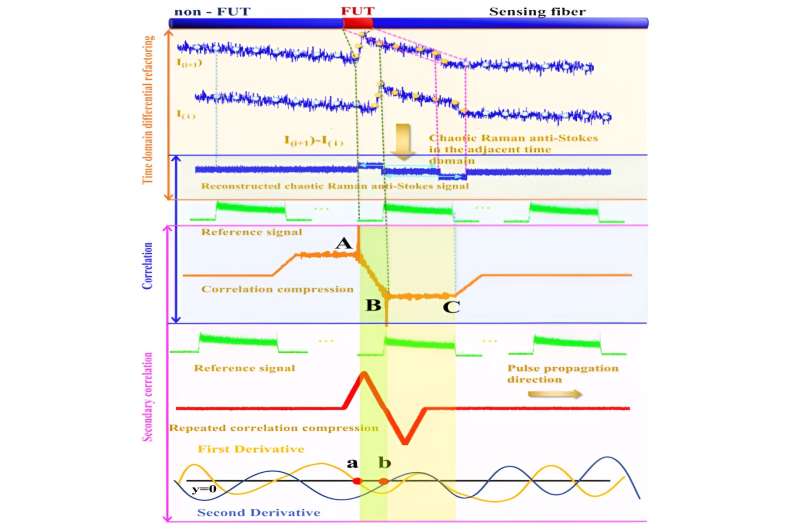This article has been reviewed according to Science X's editorial process and policies. Editors have highlighted the following attributes while ensuring the content's credibility:
fact-checked
peer-reviewed publication
proofread
Chaos Raman distributed optical fiber sensing

The timeliness and accuracy of detection technology is directly related to the safety of people's lives and property. In the application of this technology, temperature is a physical quantity that must to be focused on. Compared with other temperature measurement technologies, Raman distributed optical fiber sensors have the advantages of corrosion resistance, strong resistance to electromagnetic interference, small size of the system, low maintenance and cost, so they are widely used in pipeline leakage detection, high rock cable overload detection, warehouse fire detection and other situations.
Raman distributed optical fiber sensing is mainly based on the Raman scattering effect in optical fibers as well as optical time-domain reflection techniques to achieve fully distributed sensing along the optical fiber distribution. The spatial resolution, as an important index of this system, reflects the minimum fiber length that the sensing system can resolve when measuring the temperature field.
The spatial resolution of existing kilometer-level Raman distributed optical fiber sensing schemes is limited to the meter level, while some power equipment applications require the realization of decimeter-level spatial resolution, and thus the application of distributed optical fiber sensors in some special occasions is severely constrained.
To solve this problem, the team of Jian Li and Mingjiang Zhang from Taiyuan University of Technology proposed a high spatial resolution Raman distributed optical fiber sensing technique based on the chaotic correlation method. The research is published in the journal Light: Science & Applications.
In this work, the team proposes a new scheme using chaotic differential reconstruction and chaotic quadratic correlation algorithms to study the sensing distance and spatial resolution of chaotic Raman distributed optical fiber sensing systems. A chaotic laser is used as the light source and its autocorrelation property is utilized to eliminate the effect of the chaotic pulse width of the light source on the spatial resolution of the system.
The weak detection signal is enhanced by the quadratic correlation algorithm and derivative analysis, which solves the problem that the signal-to-noise ratio of the signal and the spatial resolution of the system cannot be reconciled in the traditional scheme.
In the article, a new chaotic Raman distributed optical fiber sensing scheme is proposed by using chaotic laser as a new type of sensing light source, the Raman backward scattering characteristics of continuous and pulsed chaotic laser in the sensing fiber and the modulation principle of FUT on the chaotic Raman scattering signals are investigated, the basic mathematical model is provided for the experiments of the chaotic ROTDR system, and the theoretical basis for the breakthrough of the limitations of spatial resolution by the pulse width of differential reconstruction and one-time correlation algorithm of the chaotic Raman backward scattering signals is analyzed specifically.
In order to solve the problem that the experimental results are greatly affected by noise, a quadratic correlation algorithm is proposed in the paper, which further demonstrates the chaotic time-domain compression and demodulation mechanism between the temperature change information and the chaotic correlation peaks, and establishes the propagation equations for the differential reconstruction of chaotic Raman backscattered signals and quadratic correlation.
Finally, the team built a chaotic ROTDR experimental platform based on the principle of chaotic ROTDR system temperature measurement. The effects of chaotic pulse width, spectral shape, chaotic bandwidth, number of chaotic sub-pulses, amplitude probability distribution, incoming power and system delay on the sensing distance and spatial resolution of the chaotic ROTDR system were investigated from theoretical and experimental perspectives.
The experiments were carried out to ensure that the above influencing factors are in the optimal state, and the obtained experimental results can accurately locate the position of the temperature change signal. Finally, a spatial resolution of 10 cm is achieved at a sensing distance of 1.5 km.
The chaotic ROTDR system was experimentally demonstrated to be able to break the suppression of spatial resolution by pulse width, and eventually achieved spatial resolution on the order of centimeters using a pulse width of 50 ns. Within the limitations of the existing spatial resolution theory, the spatial resolution of this scheme is improved by a factor of 50 over the conventional scheme.
Raman distributed optical fiber sensing technology based on chaotic correlation method optimizes the spatial resolution performance of traditional sensors, extends the application scenarios of Raman distributed optical fiber sensors, and has great application potential in some occasions where high spatial resolution is required, which provides a new research direction for optical chaos and optical fiber sensing.
More information: Chenyi Wang et al, Chaos Raman distributed optical fiber sensing, Light: Science & Applications (2023). DOI: 10.1038/s41377-023-01267-3
Journal information: Light: Science & Applications
Provided by TranSpread




















